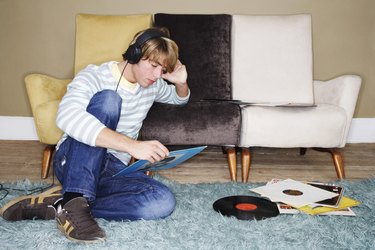
Graphic equalizers became popular in home audio applications in the late 1970s and throughout the 1980s. They can be easily recognized by their series of slide controls that divide the frequency generally from 20 Hz to 20 kHz, the approximate range of human hearing. The slide controls are centered at zero and slide up and down from zero to 3 db. Hooking up a graphic equalizer to a stereo receiver is a relatively straightforward and simple process.
Compatible Receivers
Video of the Day
A number of stereo receivers built in the '80s and '90s anticipated the sale of standalone graphic equalizers and designed their receivers with pre-amp out to amp inputs on the rear of the unit. The units came from the factory with easily removable RCA connectors in place. To hook up a graphic equalizer to such a unit, remove the plugs and connect one pair of audio cables to the pre-amp output and the other end into the left and right channel inputs on the rear panel of the graphic equalizer. Plug a second pair of audio cables from the left and right channel inputs of the amp to the output channels on the back of the graphic equalizer. Turn on both units and adjust the equalizer slide controls to your preferences.
Video of the Day
Incompatible Stereo Receivers
Stereo receivers that do not have pre-amp to amp connections can be hooked up to a graphic equalizer as long as they have an unused tape monitor connection. Plug a pair of RCA audio cables into the input sockets on the rear of the graphic equalizer. Connect the other end to the "Tape Monitor" outputs on the rear of the receiver. Connect a second pair of audio cables to the "Tape Monitor" inputs on the rear panel of the receiver. Connect the other end to outputs of the graphic equalizer. To use the graphic equalizer, turn on the receiver and open your audio source. Switch the front panel output control from its present setting to the "Tape Monitor" setting and you can use the graphic equalizer.
Receivers Without Tape Monitor Setting
If your unit does not have a tape monitor or pre-amp/amp connectors, you'll need to open the receiver case and install an input/output connection between the amplifier and the pre-amplifier. This is best accomplished by a trained audio technician.
Dolby 5.1 and 7.1 Surround Sound Receivers
With the advent of surround sound audio equipment, graphic equalizers became digitized and incorporated into the firmware of the receivers. The connection process became a single on-off switch. With the receiver turned on, find the equalizer control and switch it to the "On" position. Adjust the individual slide controls that appear on the face of the receiver (or, in some units, on the view screen of the remote control). You should be able to hear the difference in the sound coming from each speaker as you make adjustments.
- Yamaha: How Do I Hook Up An Equalizer to My Yamaha Receiver?
- Crutchfield: AudioSource EQ 200
- YouTube: Stereo Hook Up (Tuner EQ And Receiver Amp Wiring ) Part
- RadioShack: 10-Band Stereo Graphic Equalizer
- ProSoundWeb: Sound Shaping: Using Graphic Equalizers to Optimize Your System
- KenRockwell.com: Technics SH-8065